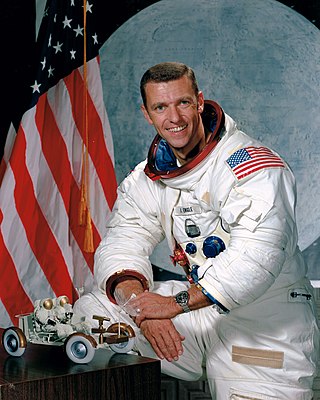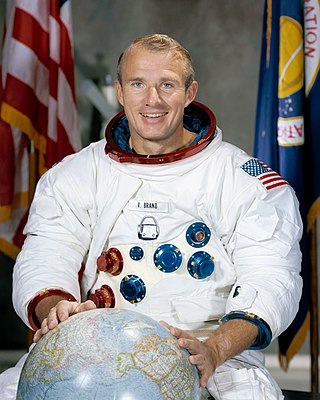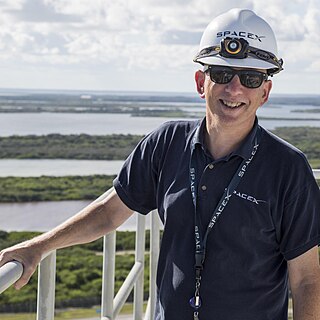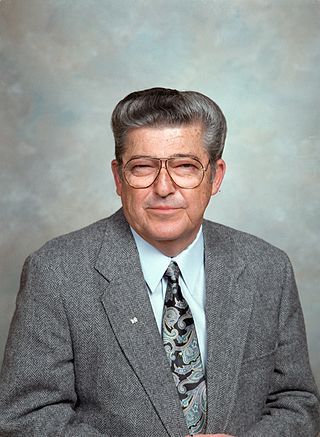Robert "Bob" S. Ryan is an American engineer who worked for NASA designing launch vehicles and coordinating technical training.
Robert "Bob" S. Ryan is an American engineer who worked for NASA designing launch vehicles and coordinating technical training.
During his career at NASA, Ryan worked on launch vehicle and space systems design and technology development, and as a Technical Training Coordinator. He retired from NASA in 1996. [1]
Ryan has also worked as an aerospace consultant for The Boeing Company on the Space Station design, and for Lockheed Martin Corporation in Huntsville on the Space Shuttle Super Light Weight tank design. He has consulted with NASA on the Space Launch Initiative, the Next Generation Launch Technology, Orbital Space Plane, the Exploration Program's Crew Launch Vehicle and Cargo Launch Vehicle, NASA NESC Smart Buyer Activity, Nuclear Propulsion Technology, MLAS Alternate Abort System test program and flight, Constellation Program, Commercial Launch Vehicles and Robust and Reliable Human Spacecraft System. In addition, he served as chairman of the X-33 Composite Fuel Tank Failure investigation, a member of the Air Force IUS failure team, and member of the Joint NASA and Air Force Launch Vehicle Integration 120 Day Study Team.
He is a contributing editor on the text book "Textbook for Space Transportation System Design" and "System Engineering". He is a co-author on the NASA TP "Launch Vehicle Design Process"; NASA CR "Lessons Learned in Engineering"; NASA CR "Engineering the System"; and is in the process of writing two additional NASA CR's: 1. "Coaching and Mentoring" and 2. "Engineering Excellence". He wrote a chapter in "50 Years of Shock and Vibration" and in "Systems Engineering" and an Agard Book, "Winds and Launch Vehicle Response".
Ryan was a NASA Flight Honoree for the Space Shuttle 100th flight and received the NASA Outstanding Leadership Medal and three Exceptional Service Medals. His was an Associate Fellow of the American Institute of Aeronautics and Astronautics (AIAA) was named the Mississippi/Alabama Section AIAA Engineer of the Year, was honored with the AIAA Herman Oberth Award by the Mississippi/Alabama Section, received the AIAA Structural Dynamics and Materials Medal, and was awarded the first AIAA Crichlow Trust Prize ($100,000).
He is a 150 Distinguished Faculty Fellow of the University of Alabama, member of the Alabama Engineering Hall of Fame, University of North Alabama Alumni of the Year, and Morgan County Alabama Sports Hall of Fame. [2]

The Rogers Commission Report was written by a Presidential Commission charged with investigating the Space Shuttle Challenger disaster during its 10th mission, STS-51-L. The report, released and submitted to President Ronald Reagan on June 9, 1986, both determined the cause of the disaster that took place 73 seconds after liftoff, and urged NASA to improve and install new safety features on the shuttles and in its organizational handling of future missions.

Robert Laurel Crippen is an American retired naval officer and aviator, test pilot, aerospace engineer, and retired astronaut. He traveled into space four times: as pilot of STS-1 in April 1981, the first Space Shuttle mission; and as commander of STS-7 in June 1983, STS-41-C in April 1984, and STS-41-G in October 1984. He was also a part of the Manned Orbiting Laboratory (MOL), Skylab Medical Experiment Altitude Test (SMEAT), ASTP support crew member, and the Approach and Landing Tests (ALT) for the Space Shuttle.

Janet Lynn Kavandi, a native of Carthage, Missouri, is an American scientist and a NASA astronaut. She is a veteran of three Space Shuttle missions, served as NASA's Deputy Chief of the Astronaut Office, and was the Center Director at the NASA Glenn Research Center in Cleveland, Ohio from March 2016 until her retirement from NASA in September 2019. She was inducted into the United States Astronaut Hall of Fame in 2019.

Frederick Hamilton "Rick" Hauck is a retired captain in the United States Navy, a former fighter pilot and NASA astronaut. He piloted Space Shuttle mission STS-7 and commanded STS-51-A and STS-26.

Joe Henry Engle is an American pilot, aeronautical engineer and former NASA astronaut. He was the commander of two Space Shuttle missions including STS-2 in 1981, the program's second orbital flight. He also flew three flights in the Shuttle program's 1977 Approach and Landing Tests. Engle is one of twelve pilots who flew the North American X-15, an experimental spaceplane jointly operated by the Air Force and NASA.

Vance DeVoe Brand is an American naval officer, aviator, aeronautical engineer, test pilot, and NASA astronaut. He served as command module pilot during the first U.S.-Soviet joint spaceflight in 1975, and as commander of three Space Shuttle missions.

Nancy Jan Davis is a former American astronaut. A veteran of three space flights, Davis logged over 673 hours in space. She is now retired from NASA.

VentureStar was a single-stage-to-orbit reusable launch system proposed by Lockheed Martin and funded by the U.S. government. The goal was to replace the Space Shuttle by developing a re-usable spaceplane that could launch satellites into orbit at a fraction of the cost. While the requirement was for an uncrewed launcher, it was expected to carry passengers as cargo. The VentureStar would have had a wingspan of 68 feet (20.7 m), a length of 127 feet (38.7 m), and would have weighed roughly 1000 t.

The Lockheed Martin X-33 was a proposed uncrewed, sub-scale technology demonstrator suborbital spaceplane that was developed for a period in the 1990s. The X-33 was a technology demonstrator for the VentureStar orbital spaceplane, which was planned to be a next-generation, commercially operated reusable launch vehicle. The X-33 would flight-test a range of technologies that NASA believed it needed for single-stage-to-orbit reusable launch vehicles, such as metallic thermal protection systems, composite cryogenic fuel tanks for liquid hydrogen, the aerospike engine, autonomous (uncrewed) flight control, rapid flight turn-around times through streamlined operations, and its lifting body aerodynamics.

Bryan Daniel O'Connor is a retired United States Marine Corps Colonel and former NASA astronaut. He was inducted into the United States Astronaut Hall of Fame in 2008.

James Shelton Voss is a retired United States Army colonel and NASA astronaut. During his time with NASA, Voss flew in space five times on board the Space Shuttle and International Space Station. He also served as deputy of Flight Operations for the Space Station Program Mission Integration and Operations Office. While participating in ISS Expedition 2, he and Susan Helms conducted an 8-hour and 56 minute spacewalk, the longest to date.

The Shuttle-C was a study by NASA to turn the Space Shuttle launch stack into a dedicated uncrewed cargo launcher. The Space Shuttle external tank and Space Shuttle Solid Rocket Boosters (SRBs) would be combined with a cargo module to take the place of the Shuttle orbiter and include the main engines. Various Shuttle-C concepts were investigated between 1984 and 1995.

John F. Muratore is a former NASA systems engineer-project manager and launch director at SpaceX. He is well known in the aerospace circles for his gregarious and unconventional style and use of rapid spiral development to reduce cost and schedule for introducing technical innovations.

Alexander A. McCool Jr. was manager of the Space Shuttle Projects Office at the NASA George C. Marshall Space Flight Center in Huntsville, Alabama. During his career, McCool contributed to several space developments including the Apollo Program, Skylab and the Space Shuttle program.

Gregory Errol Chamitoff is a Canadian-born American engineer and former NASA astronaut. He has been to space twice, spending 6 months aboard the ISS across Expedition 17 and 18 in 2008, and another 15 days as part of STS-134 in 2011. STS-134 was the last of Space Shuttle Endeavour which delivered the Alpha Magnetic Spectrometer and completed the US Orbital Segment.

James Robert Thompson Jr., known as J.R. Thompson, was the fifth director of the NASA Marshall Space Flight Center located in Huntsville, Alabama. He served as director from September 29, 1986, to July 6, 1989. Thompson also served as NASA's deputy director from July 6, 1989, to November 8, 1991.

Gene Porter Bridwell was the seventh director of the NASA Marshall Space Flight Center located in Huntsville, Alabama. He served as director from January 6, 1994, to February 3, 1996.

Gerald D. Griffin is an American aeronautical engineer and former NASA official, who served as a flight director during the Apollo program and director of Johnson Space Center, succeeding Chris Kraft in 1982.

During the lifetime of the Space Shuttle, Rockwell International and many other organizations studied various Space Shuttle designs. These involved different ways of increasing cargo and crew capacity, as well as investigating further reusability. A large focus of these designs were related to developing new shuttle boosters and improvements to the central tank, but also looked to expand NASA's ability to launch deep space missions and build modular space stations. Many of these concepts and studies would shape the concepts and programs of the 2000s such as the Constellation, Orbital Space Plane Program, and Artemis program.